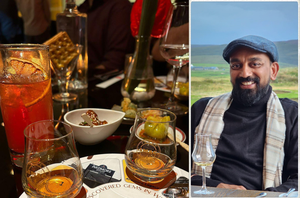New Delhi (IANS) For more than a decade, Hemanth Rao has been leading the only club in the country dedicated to single malts and if he sounds very happy, it is because the old-fashioned Indian way of having whisky, which snobs would once scoff at, is now being adopted by the world.
The founder of the Bengaluru-based Single Malt Amateur Club (SMAC) pointed out that the borrowed wisdom on all matters connected with whisky is that it’s best drunk with a splash of water at room temperature. But, today, one of the most fashionable cocktails — Japanese Highball — is a combination of whisky, soda and ice, just the way our elders would imbibe their favourite poison. And even a true-blue Scotch brand, Glenmorangie, is promoting a single malt designed only for cocktails. Whisky snobs would shudder at such blasphemy!
Rao, whose day job is with British Telecom, was presiding over a guided tasting of two lesser-known single malts — Ardmore and Bowmore from the Beam Suntory portfolio — at R.E.D., the Pan Asian restaurant at Radisson MBD in Noida, this past weekend, and he spoke to IANS from Bengaluru just hours before the event.
Looking back at SMAC’s evolution from a “friend-introduces-friend type of casual club” in 2011 to formal group with over 7,500 members, including a good number from overseas, notably Dubai and Singapore, Rao said the expansion mirrored the single malt culture’s growth in India.
Quoting a survey the SMAC conducted last year among 750-plus people across India, Rao said the Indian single malt drinker has evolved from a mindset dominated by Glenlivet and Glenfiddich to one that is curious about all the 50-odd variants now available in the country.
Easier availability of information and foreign travel have ensured that whisky lovers are looking beyond familiar labels and exploring single malts from around the world. The proliferation of Japanese single malts in the Indian market is a testament to this fact.
Japanese single malts, in fact, became fashionable in India around the same time as the rest of the world after Jim Murray, in the 2013 edition of the ‘Whisky Bible’, declared the Yamazaki 25 Years Old to be the best.
Buoyed by this heightened curiosity, Indian producers have upped the ante and moved from producing mere IMFL to rolling out single malts, including the now-globally-acclaimed brands Indri, Rampur Asava, Amrut Neidhal and Godawan 02.
As many as 47 different single malts, according to Rao, are produced in the country — and Bengaluru is the only market where you can find all of them. Does that make the southern city the hottest market for single malts in the country?
No, said Rao, the honour stays with Chandigarh and Punjab, and he attributed it to the liberal excise rules in place in the Union territory and the state famous for its prodigious appetite for whisky. It used to be said once that Punjab drank more Scotch than what was produced in Scotland, but those days belong to a time when SMAC had just a dozen-odd members in Bengaluru and Hyderabad.
The lively growth in popular interest in single malts has accelerated SMAC’s activities, too, so much so that Rao now has a business partner, Harsh Thimmaiah, who’s day job is being the manager of tennis star and restaurateur Rohan Bopanna.
The activities range from single malt events across India to brand advocacy and whisky tours (from Scotland to Singapore, where SMAC members went bar hopping, and Goa, which has become the club’s pilgrimage centre, thanks to the Paul John distillery), but the one that has caught everyone’s fancy is the club’s own single cask edition.
Every year since 2018, SMAC has been tying up with a distiller and buying a single cask that it considers to be the best. That cask then yields 150 or so bottles, which are released by the club in June. The initiative just “propelled our membership”, Rao said, and the club members are now eagerly awaiting the release of their exclusive cask-only single malt from Paul John.
And as the world follows the way Indians have been drinking whisky, Rao and the club he leads have many reasons to celebrate.


